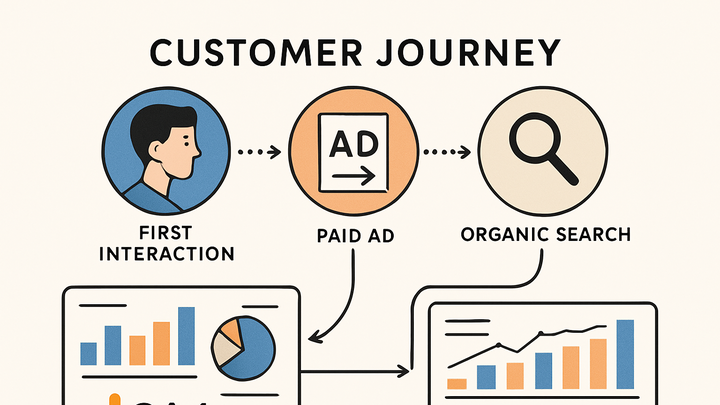Published on 2025-06-28T05:50:49Z
What is First Touch Attribution? Examples with PlainSignal and GA4
First Touch Attribution is a measurement model in analytics that gives 100% of a conversion’s credit to the very first marketing interaction a user has with a brand. This could be an organic search result click, social media ad impression, email link, or any other initial touchpoint that brought a visitor to your site. By focusing solely on that first contact, first touch attribution shines a light on which channels and campaigns are most effective at generating awareness and initiating user journeys. Its simplicity and clear-cut assignment make it straightforward to implement and communicate across teams. However, because it ignores all subsequent interactions, it can overlook essential mid- and bottom-funnel touchpoints that also contribute to conversion decisions. This model is a great starting point for businesses new to attribution but may fall short for more complex customer journeys. Analytics platforms like PlainSignal (cookie-free simple analytics) and Google Analytics 4 (GA4) both offer ways to capture and report on first touch data, either through built-in reports or customizable attribution settings.
First touch attribution
Assigns all conversion credit to a customer's first marketing interaction to highlight the most effective awareness channels.
Understanding First Touch Attribution
Dig into the concept and mechanics of first touch attribution in digital analytics.
-
Definition
First Touch Attribution is a modeling approach that assigns 100% of the credit for a conversion to the user’s first interaction with your brand or website.
-
How it works
When a user visits your site, the very first touchpoint—such as a referrer, UTM-tagged link, or ad click—is recorded. This initial channel is then credited with any subsequent conversions, regardless of later interactions.
-
Touchpoint detection
Analytics tools capture the first known interaction source by reading referrer headers and UTM parameters on the landing page.
-
Credit assignment
All conversion value is attributed to this first touchpoint, simplifying reporting but ignoring later influences.
-
Benefits and Use Cases
Explore why and when to choose first touch attribution for your marketing analysis.
-
Simplicity
Easy to implement and understand, requiring minimal configuration in most analytics platforms.
-
Awareness optimization
Ideal for campaigns focused on driving new traffic and measuring which channels generate first visits.
Limitations and Considerations
Understand the drawbacks and scenarios where first touch may not be sufficient.
-
Ignores later interactions
By focusing only on the first touch, this model overlooks mid- and bottom-funnel engagements like retargeting clicks, email follow-ups, or direct returns that may seal the deal.
-
Potential for misattribution
Can overvalue top-of-funnel channels and undervalue touchpoints later in the journey, leading to skewed ROI estimates.
Implementing First Touch Attribution in Analytics Tools
Step-by-step examples showing how to capture and report first touch data in PlainSignal and GA4.
-
PlainSignal (cookie-free analytics)
PlainSignal uses referrer and UTM data to record the first touch for each unique visitor without relying on cookies.
-
Install tracking code
Add this snippet to your site’s <head> to begin capturing first touch data:
<link rel='preconnect' href='//eu.plainsignal.com/' crossorigin /> <script defer data-do='yourwebsitedomain.com' data-id='0GQV1xmtzQQ' data-api='//eu.plainsignal.com' src='//cdn.plainsignal.com/plainsignal-min.js'></script> -
View reports
In the PlainSignal dashboard, navigate to the Attribution section and select ‘First Touch’ to see which channels brought in your first-time visitors.
-
-
Google analytics 4 (GA4)
GA4 supports first touch attribution through its configurable attribution settings.
-
Add GA4 snippet
Insert your GA4 tracking code into the <head> section:
<script async src='https://www.googletagmanager.com/gtag/js?id=G-XXXXXXX'></script> <script> window.dataLayer = window.dataLayer || []; function gtag(){dataLayer.push(arguments);} gtag('js', new Date()); gtag('config', 'G-XXXXXXX'); </script> -
Select first touch model
In the GA4 interface, go to Admin > Attribution Settings and set the default attribution model to ‘First touch’ to generate first touch conversion reports.
-
